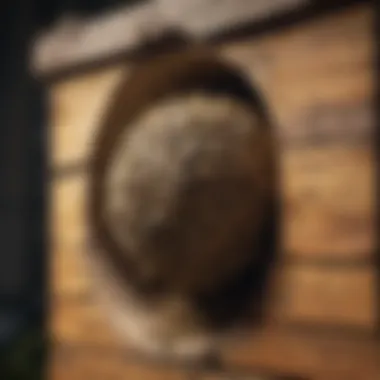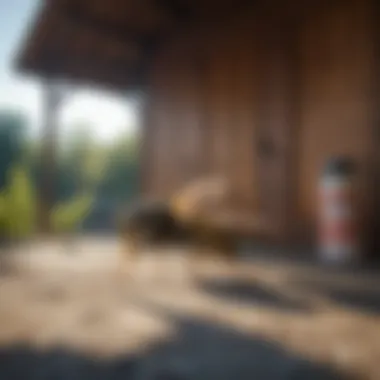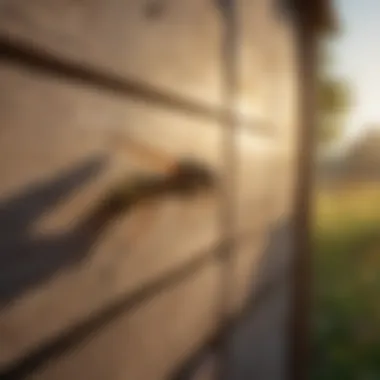Expert Tips for Maintaining a Wasp-Free Shed Environment


Preventive Pest Control Strategies
When it comes to keeping your shed free from unwanted intruders like wasps, implementing preventive pest control strategies is crucial. Starting with protecting the exterior of your house, it is important to seal any cracks and crevices that may serve as entry points for pests. Clearing debris around your property is essential to eliminate potential nesting sites for pests. By taking proactive measures to prevent pests from entering your property, you can create a barrier against infestations.
Maintaining your yard is also a key aspect of pest control. Regular yard care routines such as mowing the lawn and trimming bushes not only enhance the appearance of your property but also help keep pests at bay. Implementing methods to keep your yard pest-free, such as removing standing water and debris, can significantly reduce the likelihood of pest infestations.
Indoor cleanliness plays a significant role in preventing pests from taking up residence in your shed. Expert cleaning tips and techniques can help you create a pest-resistant indoor environment. By regularly cleaning and organizing your space, you are less likely to attract pests looking for shelter and food sources.
Proper garbage disposal is another important aspect of pest control. Efficient waste disposal methods prevent the accumulation of trash that may attract pests. Ensuring that garbage bins are tightly sealed and disposed of regularly can help deter pests from foraging around your property.
In addition to these strategies, exploring innovative ways to safeguard your home against pests, such as using natural repellents or installing pest barriers, can further fortify your defense against unwelcome guests.
Understanding Wasp Behavior
Understanding wasp behavior is crucial in the pursuit of keeping your shed wasp-free. By delving into the intricacies of how wasps behave, you gain valuable insights that can inform your prevention strategies. Wasps are territorial and can become aggressive when they feel their nest is threatened. This knowledge highlights the importance of avoiding confrontation with these insects to maintain safety and a harmonious environment in and around your shed.
Identifying Common Wasp Species


Yellow Jackets: Yellow jackets are a common type of wasp known for their yellow and black stripes. They are aggressive defenders of their nests and can sting repeatedly, posing a significant risk, especially in close proximity to your shed. Their nests are often found in wall cavities or underground, making early detection essential for effective removal.
Paper Wasps: Characterized by their paper-like nests, paper wasps are known for their elongated bodies and long legs. Paper wasps are less aggressive than yellow jackets but will sting if they feel threatened, making it important to be cautious around their nesting sites. Understanding their nesting preferences can help in locating and addressing potential infestations.
Mud Daubers: Mud daubers are solitary wasps that build their nests from mud. Unlike yellow jackets and paper wasps, mud daubers are less likely to sting, as they are not defensive of their nests. However, their presence in and around your shed can still be bothersome and may require preventive measures to deter them from nesting.
Learning About Wasp Nests
Types of Nests: Wasp nests come in various forms, including paper nests, mud nests, and underground burrows. Understanding the different types of nests can help in identifying the species of wasps present around your shed and determining the most effective removal method. Each type of nest has its unique structure and characteristics, which influence the wasps' behavior and nesting preferences.
Nesting Preferences: Wasps have specific preferences when it comes to building their nests. Some species prefer secluded areas, such as tree branches or wall voids, while others opt for sheltered spaces like sheds or attics. Recognizing the nesting preferences of different wasp species aids in locating nests and implementing targeted prevention strategies to discourage their presence.
Preventive Measures for Wasp Control
Sealing Entry Points
Gaps and Cracks


When discussing sealing entry points to prevent wasps from infiltrating your shed, addressing gaps and cracks is essential. Gaps and cracks in the structure of your shed provide easy access for wasps to build their nests and establish colonies. By identifying and sealing these openings, you create a barrier that restricts their entry, thus significantly reducing the risk of infestation. The key characteristic of addressing gaps and cracks is their role as prime entry points for wasps, making sealing them a primary focus of effective wasp control. Despite the simplicity of this method, its impact in thwarting wasps' efforts to inhabit your shed is profound. The unique feature of sealing gaps and cracks lies in its cost-effectiveness and efficiency, offering a discrete yet potent solution to ward off unwanted wasp intrusions.
Doors and Windows
Securing doors and windows of your shed is another critical aspect of preventive measures for wasp control. By ensuring that these entry points are properly sealed and fitted with screens or weather stripping, you create additional barriers against wasp intrusion. Doors and windows are common access points for wasps seeking shelter, making them vulnerable areas that require attention. The key characteristic of addressing doors and windows in this context is their susceptibility to being exploited by wasps, highlighting the importance of fortifying these openings to safeguard your shed. An advantage of focusing on doors and windows is the tangible impact it has on minimizing the risk of wasp infestation, providing a tangible and visible deterrent that contributes to your overall goal of maintaining a wasp-free shed environment.
Professional Wasp Control Methods
In this article, 'Professional Wasp Control Methods' play a crucial role in ensuring a wasp-free shed environment. When dealing with wasp infestations, it is essential to consider professional services due to their expertise and specialized knowledge in managing these insects effectively. Professional exterminators use advanced techniques and equipment to address wasp problems with precision and efficiency—bringing a wealth of benefits to the overall goal of keeping your shed free from these pests.
One key element to focus on when considering professional wasp control methods is the thoroughness of the treatment. Extermination options offered by pest control services are designed to target wasps at the source, eliminating nests and preventing future infestations. This level of precision is crucial in ensuring that all wasps are successfully eradicated, safeguarding your shed against potential re-infestation. The benefit of extermination services lies in their ability to provide a long-term solution, offering peace of mind and a sustainable wasp-free environment.
When it comes to extermination options, one of the standout features is the use of environmentally friendly pesticides that are safe for both humans and pets. This factor not only aligns with the eco-conscious efforts of many individuals but also ensures that the treatment is carried out responsibly. While discussing extermination options, it is important to highlight the quick and effective results they deliver. By targeting the root of the problem, these methods provide swift relief from wasps, making them a popular choice for those seeking immediate solutions.
Recurring inspections are another vital aspect of professional wasp control methods that contribute significantly to maintaining a wasp-free shed environment. These inspections involve regular checks by professionals to detect any signs of wasp activity promptly. By conducting recurring visits, exterminators can identify and address potential infestation risks before they escalate, ensuring comprehensive protection for your shed. The key characteristic of recurring inspections is their proactive nature, allowing for early intervention and prevention of extensive wasp damage.
The unique feature of recurring inspections lies in their preventative approach, which focuses on minimizing the likelihood of future infestations. Through routine monitoring and evaluation, pest control services can create customized plans tailored to the specific needs of your shed. This personalized attention enhances the effectiveness of the control measures employed, ultimately leading to longer-lasting results. While recurring inspections require ongoing commitment, their advantages include continuous protection and peace of mind, making them a valuable investment in maintaining a wasp-free environment.


Maintaining a Wasp-Free Shed
In this article, the focus shifts to the crucial aspect of maintaining a wasp-free shed to ensure a safe and pleasant environment. By implementing proper maintenance strategies, homeowners can effectively keep wasps at bay and protect their shed from potential infestations. Maintaining a wasp-free shed involves a combination of proactive measures, routine inspections, and educating others about the importance of a wasp-free environment.
Routine Inspections
Seasonal Check-Ups
Seasonal check-ups play a vital role in the continuous battle against wasps infiltrating sheds. Conducting regular seasonal inspections allows homeowners to monitor any potential wasp activity and identify early signs of nest formation. By inspecting the shed's exterior and interior before each season change, individuals can preemptively address any vulnerabilities or attractants that may lure wasps. Seasonal check-ups also enable the timely removal of any existing nests before they become established, preventing a full-blown infestation. The key characteristic of seasonal check-ups lies in their proactive nature, offering a preemptive strike against potential wasp problems. This practice is a popular choice for maintaining a wasp-free shed as it helps in early detection and intervention, minimizing the risk of serious infestations. While requiring regular commitment, seasonal check-ups provide homeowners with peace of mind and long-term protection against unwanted wasp colonies. One advantage of seasonal inspections is the ability to catch issues early on, ensuring minimal disruption and damage to the shed.
Early Intervention
Early intervention is a critical component of maintaining a wasp-free shed and preventing large-scale infestations. By proactively addressing any signs of wasp activity or nest building at their nascent stages, homeowners can swiftly eliminate the problem before it escalates. Early intervention tactics include promptly removing any visible nests, sealing potential entry points, and addressing factors that attract wasps to the shed. The unique feature of early intervention lies in its focus on prompt action and prevention, effectively nipping potential infestation issues in the bud. Employing early intervention measures is a beneficial choice for this article as it emphasizes the importance of taking immediate steps to deter wasps and protect the shed environment. While requiring swift action and attentiveness, early intervention offers a proactive approach to managing wasp presence and safeguarding the shed. One advantage of early intervention is the ability to address problems swiftly, reducing the likelihood of significant infestation while preserving the shed's integrity.
Educating Others
Family and Visitors
Educating family members and visitors about the importance of maintaining a wasp-free shed is essential in creating a collaborative effort towards pest control. By raising awareness about wasp behavior, nest locations, and preventive measures, individuals can contribute to the overall protection of the shed environment. Informing family members and visitors about the potential risks of attracting wasps through food sources or improper waste disposal encourages responsible behavior and vigilance. The key characteristic of involving family and visitors in educational efforts lies in fostering a sense of shared responsibility and collective action in ensuring a wasp-free shed. This approach is a beneficial choice for this article as it underscores the significance of communal involvement in pest management. By educating others, homeowners can create a supportive network that actively contributes to maintaining a safe and pest-free shed environment. One advantage of involving family and visitors is the opportunity to spread knowledge and awareness, guiding everyone towards establishing habits that discourage wasps.
Neighboring Properties
Addressing neighboring properties' impact on wasp activity is an essential aspect of maintaining a wasp-free shed. The behavior of wasps is not constrained by property boundaries, making it vital to address factors beyond one's immediate control. Communication with neighbors to coordinate pest control efforts, address shared attractants, and collectively discourage wasps from the vicinity can significantly contribute to preventing infestations. Highlighting the significance of a community-wide approach to wasp control emphasizes the interconnected nature of pest management and the importance of collaboration. This unique feature of addressing neighboring properties underscores the broader scope of pest prevention, extending efforts beyond individual sheds to create a unified front against wasp intrusion. By promoting awareness and cooperation among neighbors, homeowners can create a cohesive defense system that minimizes the risk of wasp infestations. One advantage of addressing neighboring properties is the ability to leverage collective action and resources, amplifying the impact of preventive measures across a larger area.



